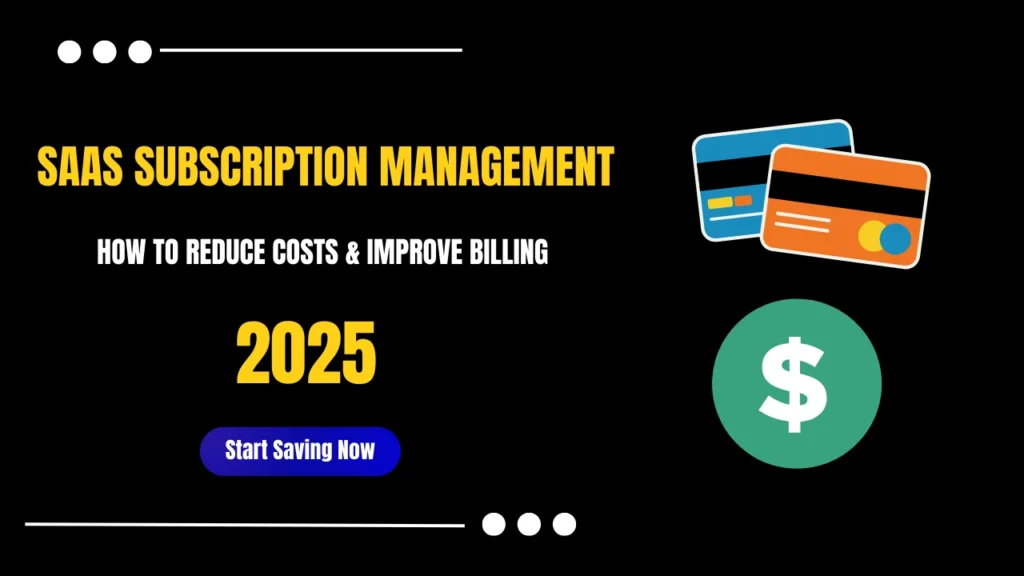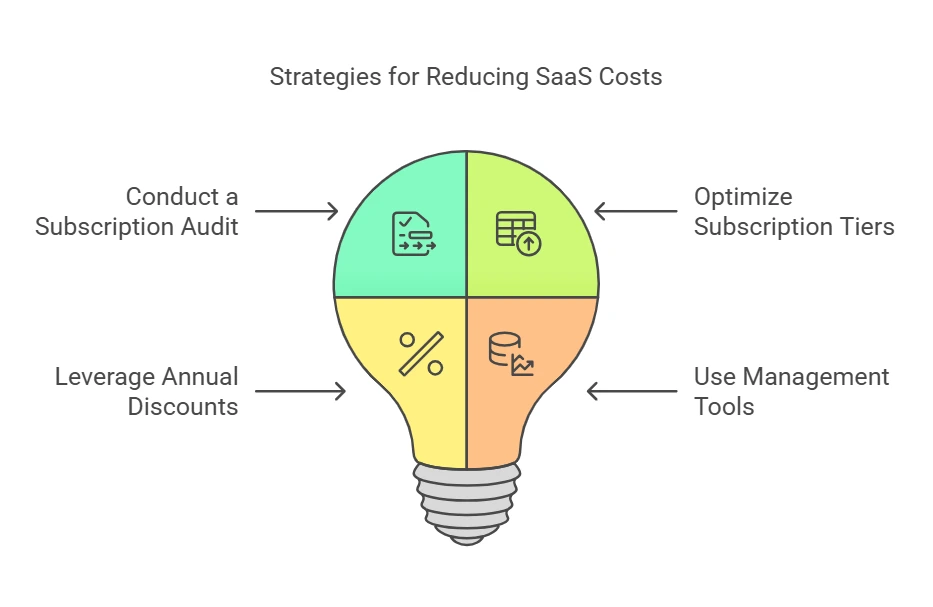
February 12, 2025 / Website
Introduction
Many businesses pay for SaaS subscriptions they rarely use or even forget about. Without a proper strategy, companies can end up overpaying for unused software or struggling with inefficient billing processes. In this guide, we’ll explore how to manage SaaS subscriptions effectively, reduce costs, and improve billing processes in 2025.
Table of Contents
- Introduction
- What is SaaS Subscription Management?
- Why is SaaS Subscription Management Important?
- How to Reduce SaaS Subscription Costs
- How to Improve SaaS Subscription Billing
- SaaS Subscription Management vs. Software Licensing
- Best SaaS Subscription Management Tools in 2025
- FAQs
- Conclusion
What is SaaS Subscription Management?
SaaS subscription management is the process of handling software-as-a-service (SaaS) subscriptions efficiently. It includes:
- Tracking active and inactive subscriptions
- Managing billing and renewals
- Optimizing subscription costs
- Ensuring compliance with software licensing agreements
By implementing a structured approach, businesses can avoid unnecessary expenses and improve productivity.
If you’re unfamiliar with SaaS and how it works, this Beginner’s Guide to Software as a Service provides an excellent overview of the fundamentals and why SaaS is crucial for modern businesses.
Why is SaaS Subscription Management Important?
With the rise of cloud-based applications, many companies use multiple SaaS products for collaboration, customer service, analytics, and more. Poor subscription management can lead to:
- Wasted Expenses: Paying for unused or duplicate subscriptions
- Billing Errors: Unclear pricing and overcharges
- Compliance Issues: Violations of software licensing agreements
- Operational Inefficiencies: Employees using outdated or unauthorized software
Imagine a company paying thousands for software they barely use. This is a common issue when SaaS subscriptions go unmanaged. In fact, According to CIO Dive, Gartner estimates that more than 30% of the $102 billion spent on SaaS in 2020 was wasted due to poor management .
To avoid this, businesses need a clear strategy—regular audits, smarter pricing choices, and automation tools to eliminate unnecessary costs.
How to Reduce SaaS Subscription Costs

1.Conduct a Subscription Audit
Start by reviewing all active SaaS subscriptions to identify unused or underutilized software. Common areas to check:
- Redundant tools with similar functions
- Unused accounts from past employees
- Software with expensive features that aren’t being used
2. Optimize SaaS Subscription Tiers Design
Most SaaS providers offer different pricing tiers. Businesses often overpay by selecting higher tiers with unnecessary features. To save costs:
- Choose the tier that matches your usage needs
- Downgrade or switch to a lower-cost plan
- Negotiate custom pricing with providers
3. Leverage Annual Billing Discounts
Many SaaS vendors offer discounts for annual plans instead of monthly payments. If a tool is essential for long-term use, switching to annual billing can save 10-30% on costs.
4. Use SaaS Subscription Management Tools
Trying to track multiple SaaS subscriptions on spreadsheets is like juggling too many balls—you’re bound to drop one. That’s where tools like Chargebee, Zuora, and Blissfully come in. They automate everything from tracking renewal dates to handling invoices, saving businesses from costly billing mistakes.
How to Improve SaaS Subscription Billing
1. Automate Billing and Payment Processes
Automating billing and payment processes reduces manual errors, improves cash flow, and ensures timely payments. By using automated billing software, businesses can:
- Generate invoices automatically based on usage or subscription plans.
- Reduce late payments through automated reminders.
- Accept multiple payment methods like credit cards, PayPal, and ACH transfers.
- Ensure secure transactions with fraud prevention mechanisms.
2. Consolidate Billing for Multiple SaaS Tools
Many businesses subscribe to multiple SaaS solutions, leading to complex billing structures. Consolidating these bills into a single payment system helps in:
- Reducing administrative workload by managing fewer invoices.
- Simplifying budget tracking and financial planning.
- Negotiating better pricing for bundled SaaS services.
- Enhancing visibility into total SaaS spending.
3.Implement Usage-Based Pricing for Cost Efficiency
Instead of flat-rate subscriptions, businesses can opt for usage-based pricing models, where charges are based on actual consumption. This helps in:
- Avoiding overpayment for unused features or services.
- Scaling costs based on business growth and usage needs.
- Encouraging efficient SaaS usage within the company.
- Offering customers flexible pricing, improving customer satisfaction.
4.Ensure Compliance with SaaS Subscription Licensing
Non-compliance with software licensing agreements can result in legal penalties and unnecessary expenses. Businesses should:
- Track software licenses to ensure they meet compliance requirements.
- Avoid unauthorized use of SaaS tools that could lead to legal issues.
- Regularly review licensing terms to ensure they align with company needs.
- Work with SaaS providers to ensure fair contract terms and renewals.
SaaS Subscription Management vs. Software Licensing
SaaS subscription management and traditional software licensing serve different purposes:
| Feature | SaaS Subscription Management | Software Licensing |
| Payment Model | Recurring payments (monthly/annually) | One-time purchase or periodic renewals |
| Access | Cloud-based, accessible from anywhere | Installed on specific devices |
| Scalability | Easily scalable based on need | Requires new licenses for expansion |
| Updates | Continuous updates included | Requires manual upgrades |
| Cost Structure | Lower upfront costs, flexible pricing | Higher initial costs, long-term savings |
For modern businesses, SaaS subscription management offers greater flexibility and cost efficiency, whereas software licensing is suitable for companies needing on-premise control.
Best SaaS Subscription Management Tools in 2025
1. Chargebee (Chargebee) is a leading SaaS billing platform that automates subscription billing, invoicing, and revenue recognition. Key features include:
- Automated billing workflows
- Customizable subscription plans
- Tax compliance and financial reporting
- Compatible with leading accounting platforms such as QuickBooks and Xero.
2. Blissfully (Blissfully) is a SaaS management platform that helps businesses track, manage, and optimize their subscriptions. It provides:
- Full visibility into SaaS spending
- Automated renewal reminders
- User access controls to prevent shadow IT
- Detailed SaaS usage analytics
3. Zuora (Zuora) specializes in enterprise-grade subscription billing, helping businesses manage large-scale SaaS operations. Key capabilities include:
- Advanced billing automation
- Flexible pricing models (usage-based, flat-rate, hybrid)
- Revenue forecasting and analytics
- Seamless integration with CRM and ERP systems
4. Paddle (Paddle) is a comprehensive SaaS commerce platform designed for companies selling globally. It offers:
- Simplified global tax compliance
- All-in-one payment processing
- Subscription retention tools to reduce churn
- Fraud protection and risk management
5. Intello (Intello) is a SaaS operations platform focused on SaaS spend management and compliance tracking. Features include:
- Automated SaaS discovery and cost analysis
- Shadow IT detection and governance
- Contract negotiation support for better pricing
- Compliance tracking for software licensing agreements
Conclusion
Many businesses don’t realize they’re spending too much on SaaS tools. This leads to wasted money.
For example, a startup subscribed to multiple project management apps without realizing employees were only using one. By auditing their subscriptions and switching to a lower-cost plan, they saved 30% annually.
Additionally, staying informed about best practices in SaaS billing ensures compliance and prevents financial losses. Businesses should prioritize choosing scalable and flexible solutions that match their operational needs.
With the right strategy and tools, organizations can enhance their financial planning, reduce software waste, and improve operational efficiency. Don’t let poor subscription management drain your resources—take charge today!
🚀 Tired of wasting money on unused SaaS tools? It’s time to take back control. Start optimizing your software stack, cut unnecessary costs, and streamline your billing today. Explore top-rated tools like Chargebee to automate the process and stay ahead in 2025!
FAQs
1. What is the best way to manage multiple SaaS subscriptions?
The best way to manage multiple SaaS subscriptions is by using SaaS subscription management tools like Chargebee, Blissfully, or Zuora. These platforms provide visibility into all subscriptions, track costs, send renewal reminders, and automate billing.
2. How can businesses reduce SaaS subscription costs?
Businesses can reduce costs by:
- Conducting a subscription audit to eliminate unused tools
- Choosing the right SaaS subscription tier
- Taking advantage of annual billing discounts
- Negotiating better rates with providers
- Using automated management tools to track spending
3. What is the difference between SaaS subscription management and software licensing?
SaaS subscription management focuses on handling cloud-based software subscriptions, including billing, renewals, and usage tracking. Software licensing, on the other hand, involves one-time purchases or perpetual licenses that require periodic renewals or maintenance fees.
4. Why do companies overpay for SaaS subscriptions?
Think of it this way: Would you pay for a premium gym membership if you only use the treadmill? Many companies make the same mistake with SaaS. They subscribe to premium plans packed with features they never use, wasting thousands every year. A structured subscription management strategy can prevent these issues.
5. What are the risks of poor SaaS subscription management?
The risks include financial waste, compliance violations, security vulnerabilities, and inefficiencies in software usage. Poor management can lead to unnecessary expenses and operational disruptions.
